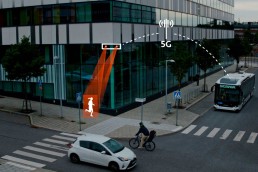Four years ago, representatives from the telecoms industry, academia and the public sector teamed up to test a 5G-connected autonomous vehicle for public transport. Today, the project has expanded with new partners and resulted in technical solutions that make autonomous vehicles better in terms of safety and security while efficiently integrated in the transport system.
Back in 2020, Kista Science City, Ericsson, Telia, Keolis and Intel, with financing from Vinnova and Drive Sweden, launched the 5G-connected and autonomous electric minibus 5G Ride on the island of Royal Djurgården in the Swedish capital, Stockholm. Prince Daniel of the Swedish Royal Family was among the dignitaries that attended the official inauguration ceremony. Since then, Scania, KTH, Region Stockholm, T-Engineering, Viscando, Vy and Applied Autonomy have joined the project, putting focus into technical solutions that make autonomous vehicles safe in traffic, secure for passengers and efficiently integrated in the overall transport system.
Subsequent achievements include further developing the Traffic Tower concept from Applied Autonomy using a 5G connection to monitor and manage fleets of self-driving vehicles on public roads, as well as deploying sensors in infrastructure that enhance the traffic perception of self-driving vehicles by sharing real-time traffic data via a low latency reliable 5G network.
Throughout the project, the goal has been to ensure safety and stability for solutions to be implemented in regular traffic, and to make 5G-enabled electric driverless public transport services a reality. Ericsson has contributed with a private 5G network to evaluate how new features in 5G can support the use cases in question. Telia provided connectivity through its public 5G network and a private 5G network at Scania’s test track in Södertälje in collaboration with Ericsson. Intel delivered analytics and processing for onboard AI, while both Scania and Applied Autonomy delivered vehicle and self-driving technology. Viscando provided smart 3D&AI based infrastructure sensors, and KTH conducted research on both 5G network capacity and advanced sensor fusion and driving logics. In addition, Vy Buss has investigated how customers experience safety on board when the bus is driven without a safety driver. Through focus groups, Vy has also investigated how communication between the control tower and the bus worked in an emergency.
On September 26, the Future 5G Ride project will showcase key enablers for autonomous transport in Kista Innovation Park, focusing on safe and inclusive journeys. Visitors can experience a ride in the driverless vehicle and learn about crucial aspects such as robustness, passenger interaction and the ability of 5G to serve various strict application requirements on demand – known as differentiated connectivity.
Lucas Uhlén, Project Manager at Kista Science City, says: “The 5G Ride project unites a diverse consortium of partners, working together to challenge and innovate within autonomous driving and sustainable public transport. Kista Science City continues to play a supportive role in expanding these partnerships, bringing in new collaborators, and ensuring that the technical development of each partner is aligned with the overall goals of the project. By bringing together different perspectives and expertise, we are accelerating innovation and creating scalable solutions for the future of public transport.”
Magnus Leonhardt, Head of Strategy & Innovation, Telia B2B, says: “The 5G Ride project has given us unique insights around the demands on connectivity, and 5G specifically, to enable self-driving vehicles to be deployed safely in public transport. We have also had the opportunity to use our joint capabilities in our 5G-innovation program NorthStar, that we run with Ericsson and that Scania is also part of, to trial key scenarios in the 5G Ride-project. We look forward to continuing this work with customers and partners in public transport and the automotive industry, to allow for the transition to safer, more efficient, and sustainable solutions for public transport.”
Håkan Olofsson, Head of Systems Concepts & Algorithms, Ericsson, says: “5G Ride is a good example of a use case with strict 5G requirements. The project shows that when these strict 5G requirements arise during a journey, 5G capabilities are provided instantly via network APIs, that allow application developers to easily access 5G capabilities such as differentiated connectivity. Ericsson’s network support for differentiated connectivity ensures a reliable network performance, even at times of peak network load.”
Olav Madland, CEO of Applied Autonomy AB, is enthusiastic about scaling these autonomous transport services in Sweden and Europe. He says: “Based on the outcomes of this project, mobility operators can offer passengers a seamless and comfortable experience in driverless vehicles. Our Control Tower, xFlow, leverages integrations with Ericsson and Intel to provide a comprehensive solution for operators.”

